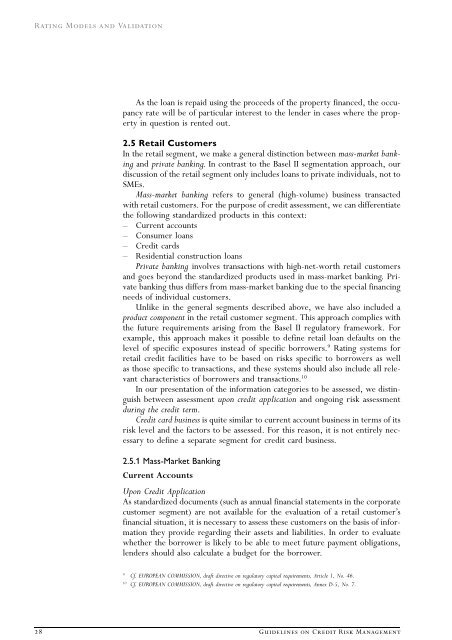Rating Models and Validation - Oesterreichische Nationalbank
Rating Models and Validation - Oesterreichische Nationalbank
Rating Models and Validation - Oesterreichische Nationalbank
Create successful ePaper yourself
Turn your PDF publications into a flip-book with our unique Google optimized e-Paper software.
<strong>Rating</strong> <strong>Models</strong> <strong>and</strong> <strong>Validation</strong><br />
As the loan is repaid using the proceeds of the property financed, the occupancy<br />
rate will be of particular interest to the lender in cases where the property<br />
in question is rented out.<br />
2.5 Retail Customers<br />
In the retail segment, we make a general distinction between mass-market banking<br />
<strong>and</strong> private banking. In contrast to the Basel II segmentation approach, our<br />
discussion of the retail segment only includes loans to private individuals, not to<br />
SMEs.<br />
Mass-market banking refers to general (high-volume) business transacted<br />
with retail customers. For the purpose of credit assessment, we can differentiate<br />
the following st<strong>and</strong>ardized products in this context:<br />
— Current accounts<br />
— Consumer loans<br />
— Credit cards<br />
— Residential construction loans<br />
Private banking involves transactions with high-net-worth retail customers<br />
<strong>and</strong> goes beyond the st<strong>and</strong>ardized products used in mass-market banking. Private<br />
banking thus differs from mass-market banking due to the special financing<br />
needs of individual customers.<br />
Unlike in the general segments described above, we have also included a<br />
product component in the retail customer segment. This approach complies with<br />
the future requirements arising from the Basel II regulatory framework. For<br />
example, this approach makes it possible to define retail loan defaults on the<br />
level of specific exposures instead of specific borrowers. 9 <strong>Rating</strong> systems for<br />
retail credit facilities have to be based on risks specific to borrowers as well<br />
as those specific to transactions, <strong>and</strong> these systems should also include all relevant<br />
characteristics of borrowers <strong>and</strong> transactions. 10<br />
In our presentation of the information categories to be assessed, we distinguish<br />
between assessment upon credit application <strong>and</strong> ongoing risk assessment<br />
during the credit term.<br />
Credit card business is quite similar to current account business in terms of its<br />
risk level <strong>and</strong> the factors to be assessed. For this reason, it is not entirely necessary<br />
to define a separate segment for credit card business.<br />
2.5.1 Mass-Market Banking<br />
Current Accounts<br />
Upon Credit Application<br />
As st<strong>and</strong>ardized documents (such as annual financial statements in the corporate<br />
customer segment) are not available for the evaluation of a retail customerÕs<br />
financial situation, it is necessary to assess these customers on the basis of information<br />
they provide regarding their assets <strong>and</strong> liabilities. In order to evaluate<br />
whether the borrower is likely to be able to meet future payment obligations,<br />
lenders should also calculate a budget for the borrower.<br />
9 Cf. EUROPEAN COMMISSION, draft directive on regulatory capital requirements, Article 1, No. 46.<br />
10 Cf. EUROPEAN COMMISSION, draft directive on regulatory capital requirements, Annex D-5, No. 7.<br />
28 Guidelines on Credit Risk Management

















